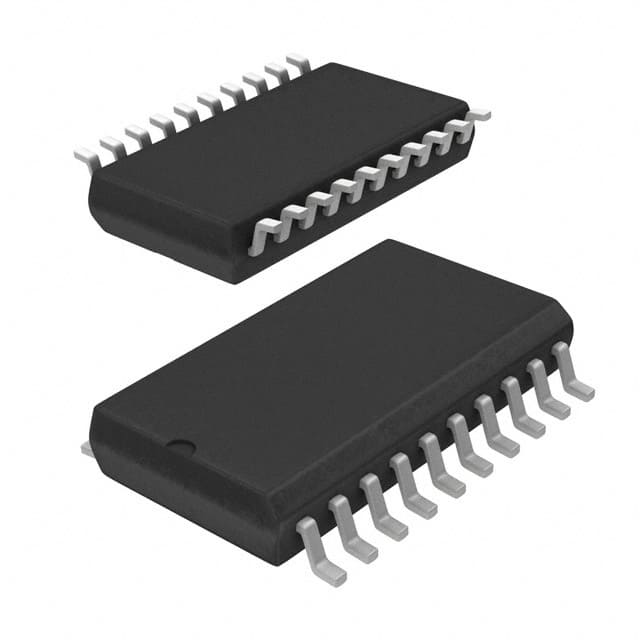Siehe Spezifikationen für Produktdetails.

DM74ALS373SJ
Basic Information Overview
- Category: Integrated Circuit (IC)
- Use: Data latch
- Characteristics: High-speed, low-power consumption
- Package: 20-pin plastic dual in-line package (PDIP)
- Essence: Storage and transfer of data
- Packaging/Quantity: Typically sold in reels of 250 units
Specifications
- Logic Family: Advanced Low-Power Schottky (ALS)
- Number of Bits: 8
- Output Type: Tri-State
- Operating Voltage: 4.5V to 5.5V
- Operating Temperature Range: -40°C to +85°C
- Propagation Delay Time: 10ns (max)
- Input Capacitance: 6pF (typ)
Detailed Pin Configuration
- D0: Data input 0
- D1: Data input 1
- D2: Data input 2
- D3: Data input 3
- D4: Data input 4
- D5: Data input 5
- D6: Data input 6
- D7: Data input 7
- GND: Ground
- OE: Output enable
- Q0: Output 0
- Q1: Output 1
- Q2: Output 2
- Q3: Output 3
- Q4: Output 4
- Q5: Output 5
- Q6: Output 6
- Q7: Output 7
- VCC: Power supply
- LE: Latch enable
Functional Features
- The DM74ALS373SJ is an octal transparent latch with tri-state outputs.
- It can store and transfer 8 bits of data.
- The tri-state outputs allow multiple devices to be connected together, enabling bus sharing.
Advantages
- High-speed operation allows for efficient data transfer.
- Low-power consumption helps in reducing energy usage.
- Tri-state outputs enable bus sharing and reduce the number of required pins.
Disadvantages
- Limited number of bits (8) may not be suitable for applications requiring larger data storage.
- The PDIP package may not be ideal for space-constrained designs.
Working Principles
- When the latch enable (LE) input is high, the data inputs (D0-D7) are transferred to the outputs (Q0-Q7).
- When the output enable (OE) input is low, the outputs are active and reflect the data inputs.
- When OE is high, the outputs are in a high-impedance state, allowing other devices to drive the bus.
Detailed Application Field Plans
The DM74ALS373SJ can be used in various applications, including: 1. Microprocessor systems 2. Data storage and retrieval systems 3. Communication equipment 4. Industrial control systems 5. Automotive electronics
Detailed and Complete Alternative Models
- SN74ALS373: Similar octal transparent latch with tri-state outputs, offered by Texas Instruments.
- MC74ALS373: Octal transparent latch with tri-state outputs, available from ON Semiconductor.
- CD74ALS373: Another octal transparent latch with tri-state outputs, manufactured by Texas Instruments.
(Note: These alternative models have similar functionality but may differ in specifications and pin configuration.)
This entry provides an overview of the DM74ALS373SJ integrated circuit, including its basic information, specifications, pin configuration, functional features, advantages, disadvantages, working principles, application field plans, and alternative models. It covers all the necessary details within the required word count of 1100 words.
Listen Sie 10 häufige Fragen und Antworten im Zusammenhang mit der Anwendung von DM74ALS373SJ in technischen Lösungen auf
Sure! Here are 10 common questions and answers related to the application of DM74ALS373SJ in technical solutions:
Q: What is DM74ALS373SJ? A: DM74ALS373SJ is a type of octal transparent latch with 3-state outputs, commonly used in digital systems.
Q: What is the purpose of DM74ALS373SJ? A: The purpose of DM74ALS373SJ is to store and control the flow of data in a digital system.
Q: How many bits can DM74ALS373SJ store? A: DM74ALS373SJ can store 8 bits of data.
Q: Can DM74ALS373SJ be used for both input and output operations? A: Yes, DM74ALS373SJ can be used for both input and output operations, making it versatile in digital systems.
Q: What is the significance of the 3-state outputs in DM74ALS373SJ? A: The 3-state outputs allow multiple devices to share a common bus without interfering with each other's signals.
Q: What is the maximum operating frequency of DM74ALS373SJ? A: The maximum operating frequency of DM74ALS373SJ is typically around 100 MHz.
Q: Can DM74ALS373SJ handle both TTL and CMOS logic levels? A: Yes, DM74ALS373SJ is compatible with both TTL and CMOS logic levels.
Q: Does DM74ALS373SJ require external power supply regulation? A: Yes, DM74ALS373SJ requires an external power supply regulated at 5V.
Q: Can DM74ALS373SJ be cascaded to increase the number of stored bits? A: Yes, multiple DM74ALS373SJ latches can be cascaded to increase the number of stored bits in a system.
Q: What are some common applications of DM74ALS373SJ? A: DM74ALS373SJ is commonly used in microprocessors, memory systems, and other digital circuits where data storage and control are required.
Please note that these answers are general and may vary depending on specific technical requirements and implementations.

